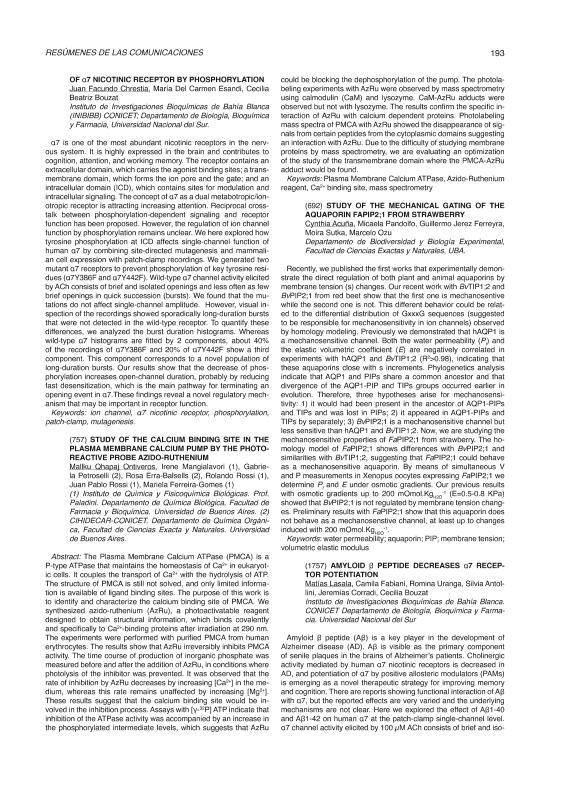Evento
Amyloid β peptide decreases α7 receptor potentiation
Lasala, Matías Marcelo ; Fabiani, Camila
; Fabiani, Camila ; Uranga, Romina Maria
; Uranga, Romina Maria ; Antollini, Silvia Susana
; Antollini, Silvia Susana ; Corradi, Jeremias
; Corradi, Jeremias ; Bouzat, Cecilia Beatriz
; Bouzat, Cecilia Beatriz
 ; Fabiani, Camila
; Fabiani, Camila ; Uranga, Romina Maria
; Uranga, Romina Maria ; Antollini, Silvia Susana
; Antollini, Silvia Susana ; Corradi, Jeremias
; Corradi, Jeremias ; Bouzat, Cecilia Beatriz
; Bouzat, Cecilia Beatriz
Tipo del evento:
Reunión
Nombre del evento:
Reunión Conjunta de Sociedades de Biociencias
Fecha del evento:
13/11/2017
Institución Organizadora:
Sociedad Argentina de Investigación Clínica;
Sociedad Argentina de Investigación Bioquímica y Biología Molecular;
Sociedad Argentina de Inmunología;
Sociedad Argentina de Andrologia;
Sociedad Argentina de Biofísica;
Sociedad Argentina de Farmacología Experimental;
Sociedad Argentina de Fisiologia;
Sociedad Argentina de Protozoologia;
Título de la revista:
Medicina (Buenos Aires)
Editorial:
Fundación Revista Medicina
ISSN:
0025-7680
e-ISSN:
1669-9106
Idioma:
Inglés
Clasificación temática:
Resumen
Amyloid β peptide (Aβ) is a key player in the development of Alzheimer disease (AD). Aβ is visible as the primary component of senile plaques in the brains of Alzheimer’s patients. Cholinergic activity mediated by human α7 nicotinic receptors is decreased in AD, and potentiation of α7 by positive allosteric modulators (PAMs) is emerging as a novel therapeutic strategy for improving memory and cognition. There are reports showing functional interaction of Aβ with α7, but the reported effects are very varied and the underlying mechanisms are not clear. Here we explored the effect of Aβ1-40 and Aβ1-42 on human α7 at the patch-clamp single-channel level. α7 channel activity elicited by 100 µM ACh consists of brief and iso lated openings. In the presence of PAMs, open channel lifetime is increased and openings appear grouped in long activation episodes. The type II PAM PNU-120596 (1 µM) prolongs open durations and elicits activation episodes of ~2 s. In the presence of Aβ there is a statistically significant decrease in the mean duration of the po tentiated activation episodes, which is 2.6-fold at 100 nM Aβ1-40 (p<0.001, n=11) and 2-fold at 100 nM Aβ1-42 (p<0.05, n=10). To determine if the effect is specific for PNU-120596, we also tested NS-1738, which is an α7 type I PAM. Again, a 2-fold reduction in the duration of the activation episodes is observed (p<0.001). Com plementary fluorescence spectroscopic studies using a fluorescent channel blocker, crystal violet, that binds with different affinities to resting and desensitized receptors provide insights into the function al changes. Our results demonstrate that Aβ inhibits potentiation of human α7, probably through an allosteric mechanism which involves slow block or increased desensitization. Deciphering the functional interaction between α7 and Aβ contributes to the understanding of the involvement of α7 in the pathophysiology of Alzheimer disease.
Palabras clave:
Amyloid β peptide
,
nicotinic receptor
,
Patch-clamp
,
ion channel
Archivos asociados
Licencia
Identificadores
Colecciones
Eventos(INIBIBB)
Eventos de INST.DE INVEST.BIOQUIMICAS BAHIA BLANCA (I)
Eventos de INST.DE INVEST.BIOQUIMICAS BAHIA BLANCA (I)
Citación
Amyloid β peptide decreases α7 receptor potentiation; Reunión Conjunta de Sociedades de Biociencias; Buenos Aires; Argentina; 2017; 193-194
Compartir



